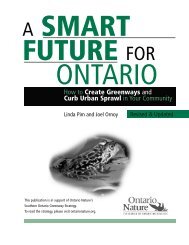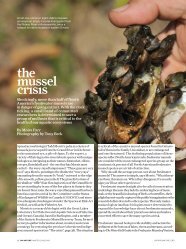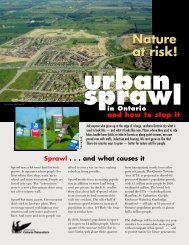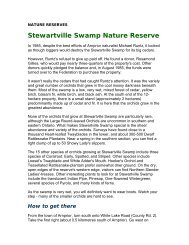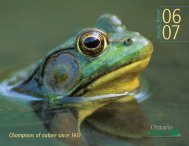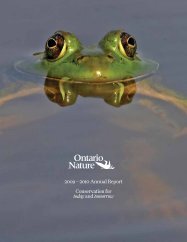SPECIES OF ONTARIO CRAYFISH - Ontario Nature
SPECIES OF ONTARIO CRAYFISH - Ontario Nature
SPECIES OF ONTARIO CRAYFISH - Ontario Nature
Create successful ePaper yourself
Turn your PDF publications into a flip-book with our unique Google optimized e-Paper software.
<strong>CRAYFISH</strong><br />
Distribution of<br />
Native Crayfish<br />
If you go south there are more<br />
native crayfish species.<br />
Only C. bartonii has a<br />
southern range limit in <strong>Ontario</strong>.<br />
number of<br />
native<br />
species<br />
Cambarus<br />
bartonii shown<br />
as stippled area<br />
THE ECOLOGICAL<br />
IMPORTANCE <strong>OF</strong> <strong>CRAYFISH</strong><br />
Crayfish are our largest freely-mobile invertebrate<br />
animal. They consume a wide variety of foods, and<br />
are eaten by a great diversity of other animals.<br />
Each crayfish species has a different lifestyle, and a<br />
different effect on the aquatic community it lives in. As<br />
we learn more about their populations, crayfish can<br />
teach us about the health of aquatic environments.<br />
ARE SOME <strong>CRAYFISH</strong><br />
DISAPPEARING?<br />
<strong>Ontario</strong> crayfish are subject to all the usual<br />
causes of population extinction:<br />
<br />
habitat destruction<br />
<br />
invasive aliens<br />
<br />
pollution, and other mysterious causes.<br />
Nine crayfish species are known from <strong>Ontario</strong>, plus<br />
one spreading up the St. Lawrence R. from Quebec.<br />
Burrowing species are eliminated where wetlands<br />
and ditches are destroyed, and alien species<br />
displace native populations in many waters.<br />
Crayfish are absent from some degraded urban<br />
streams, and in some lakes on the Shield, crayfish<br />
have disappeared without explanation.<br />
FIND OUT MORE AT www.crayfishontario.ca<br />
antenna<br />
female<br />
chela<br />
antennule<br />
rostrum<br />
male<br />
LIFESTYLES<br />
THE SHAPE <strong>OF</strong> <strong>CRAYFISH</strong><br />
Some crayfish live permanently in streams and<br />
lakes, while others burrow in soil, living for most of<br />
the year in deep burrows topped with chimneys of<br />
mud balls. Cambarus species are active mostly<br />
at night, while Orconectes are<br />
more often seen out from<br />
under cover during the day.<br />
At night one sometimes<br />
sees crayfish up on land,<br />
foraging or travelling<br />
between pools of water.<br />
Crayfish “chimney”<br />
made of mud balls<br />
HOW TO FIND <strong>CRAYFISH</strong><br />
You can seek crayfish either passively or<br />
actively. Passive searching consists of<br />
identifying the shells or dead individuals<br />
seen along shores or in the water, and in<br />
the stomachs of fish taken by angling.<br />
Active searching can be almost any<br />
method used for monitoring aquatic<br />
animals: turning stones with a dipnet,<br />
seining, baited or unbaited minnowtraps,<br />
or dipnetting through aquatic vegetation.<br />
KEEP IN MIND THAT TRANSPORTATION <strong>OF</strong> LIVE<br />
<strong>CRAYFISH</strong> BETWEEN WATER BODIES IS ILLEGAL<br />
carapace<br />
abdomen<br />
telson<br />
Anterior<br />
copulatory<br />
stylet (used in<br />
identification)<br />
<strong>ONTARIO</strong><br />
Because crayfish<br />
distributions are changing so<br />
rapidly, you may be the first<br />
to identify and report a<br />
particular species in a place<br />
where it has not been known<br />
to science.<br />
FIND OUT<br />
<br />
What to record<br />
<br />
Tips for observation<br />
<br />
Safety and ethics<br />
<br />
What and when to collect<br />
<br />
Who to contact<br />
TO KNOWLEDGE<br />
<strong>CRAYFISH</strong><br />
gonopore<br />
Copulatory<br />
stylets<br />
swimmerets<br />
Posterior stylet<br />
swimmeret<br />
CONTRIBUTE<br />
ABOUT<br />
<strong>ONTARIO</strong>.CA<br />
WWW.<strong>CRAYFISH</strong>



